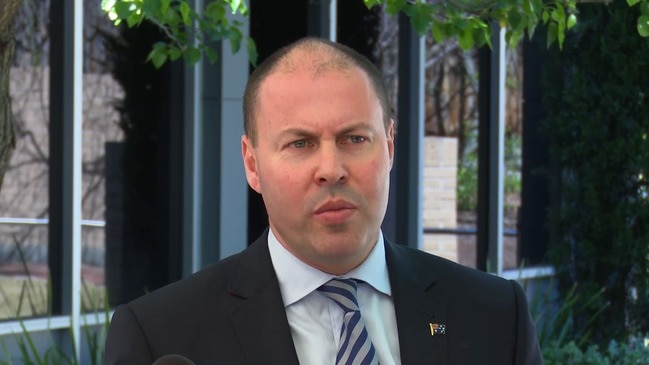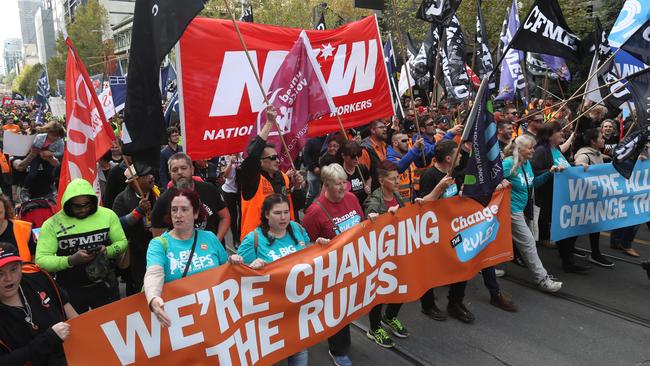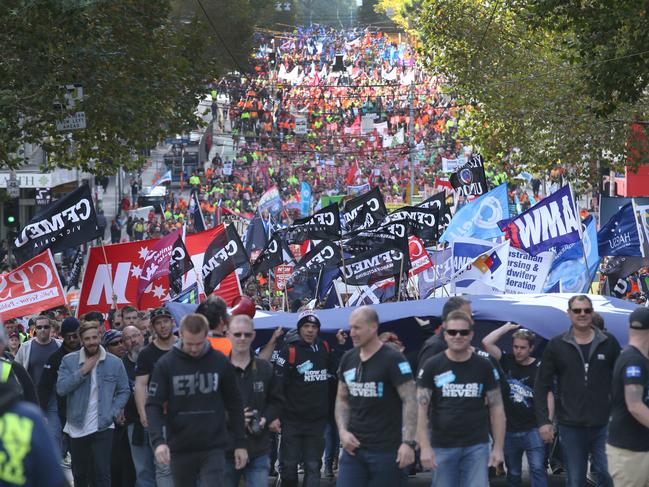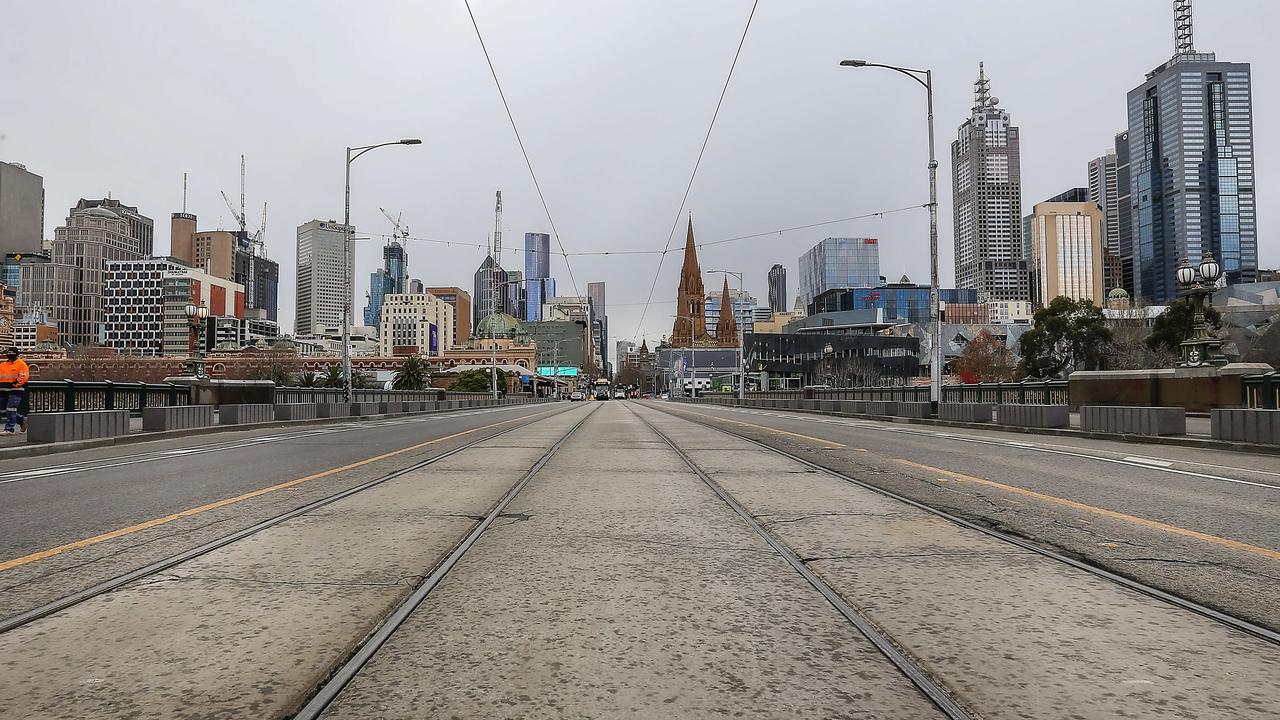Unions are trading on their history
UNIONS will rally again soon to try to “change the rules” but the fact is that few of us have any connection to the union movement, writes Shaun Carney.

Opinion
Don't miss out on the headlines from Opinion. Followed categories will be added to My News.
THE Liberal Party and the ACTU obviously don’t agree on much but right now, for different reasons, they’re running what amounts to a unity ticket on the power of unions to change the country.
The government’s line is that the unions are only ever one strike away from laying waste to the economy and that under Labor, national devastation would be assured. That is chiefly because the ALP is headed by former national union secretary Bill Shorten who, as the ex-creator of tourism advertising lines Scott Morrison enjoys telling us, is “union-bred, union-fed and union-led”.
The attack on Shorten is pivotal to the government’s campaign for re-election. It’s not too much to say the government is pinning its hopes on the Shorten-as-reckless-union-stooge to get it over the line in a tight contest.
UNION RALLY EXPECTED TO ‘HALT’ MELBOURNE
GOVT LOOKS OTHER WAY AS ACTU CHOKES MELBOURNE
UNIONS SHUT DOWN CITY, HIT THE PUB
At the same time, the ACTU is also pumping up its ability to influence the laws of the nation. On October 23, it aims to attract 150,000 people to a rally in Melbourne in support of a new industrial relations system, which could include a return to co-ordinated industry-wide bargaining for wages and conditions. If that’s the attendance, it will rank as Melbourne’ biggest public demonstration — bigger than the anti-Vietnam Moratorium protest of 1970 and the march against the Kennett government’s industrial laws in 1992. There will also be rallies in Sydney, Wollongong, Cairns, Townsville, Gladstone and Rockhampton.
There’s something nostalgic about this. It harks back to a time when unions really were central to the daily economic life of Australia.
That really cannot be said of unions today. Sure, they remain important players but more as influencers than as direct stakeholders.
The best way to explain the difference is to go back to 1969, when the Victorian secretary of the tramways union, Clarrie O’Shea, a communist, was jailed for refusing to pay fines for the union’s past industrial action. In the following days, one million workers around the country — about one-fifth of the workforce — went on strike to protest against the Industrial Court’s use of penal powers. Bear in mind, all strike action back then was illegal.

Soon enough, an anonymous benefactor paid the fines and an unrepentant O’Shea was released. But the nationwide industrial action killed the penal powers in the Conciliation and Arbitration Act. They stayed on the statutes but weren’t used again.
That was direct action, made possible because more than half of the nation’s employees belonged to unions and there was a high proportion of blue-collar workers.
Since the early 1990s and the introduction of enterprise bargaining, that has changed dramatically.
In 1996, about 30 per cent of workers were unionists and every third worker was blue-collar. Now, unionism stands about 14 per cent and the blue-collar proportion of the workforce is about one in five.
That’s why union campaigning today is less at workplaces and more at big, scheduled events such as this month’s rallies and in the media via advertising.
The ACTU’s “Change the Rules” campaign, which has been running for some months now, began by bemoaning the actions of bosses who cleaned up while workers couldn’t make ends meet. New ads have adopted a more aggressive tone, urging workers to “stand together” to take it up to the companies who are “ripping us off”.

The sentiment is something that many might connect with but only indirectly because they have no contact with unions. This is what’s jarring about the incessant warnings issued by the Prime Minister and his colleagues about the imminent takeover of the country by the ACTU secretary, Sally McManus, and her comrades under Labor.
Unions simply aren’t central to the lives of most households or businesses and even if unions win some enhanced powers, that won’t change. Unless they’re inconveniencing us by holding up traffic when they’re on a protest march, they rarely have a direct effect on the lives of most of us — certainly not in the way that they did a generation ago.
There’s no question that a few unions all too willingly cut up rough. Inevitably, that creates complications for Shorten and all Labor leaders, given that the unions are affiliated to the ALP.
But I wonder if it’s as much of a negative as the government believes. After all, unions have been the mainstay of the Labor Party since it began and were much more troublesome in the past than they are now.
It might even be that the focus on the activities of a small handful of high-profile militant unions leaders, such as John Setka from the CFMMEU and Firefighters’ Union secretary Peter Marshall, demonstrates how tangential most unions are to most people’s everyday lives. Unless you’re involved in large building projects or unfortunate enough to need the fire service, what they do isn’t something you’re going to have experience of.
That contrasts with the way it was not all that long ago. There were beer strikes, petrol strikes, power strikes, train strikes — you name it. We just don’t live or work the way we used to, and that places limits on how much unions can re-enter workplaces and the economy.
Of course, unions still play a role in public life, setting pay standards and advocating for a bigger share for workers. But Clarrie O’Shea isn’t coming back, as much as the PM might secretly like that.
Shaun Carney is a Herald Sun columnist


